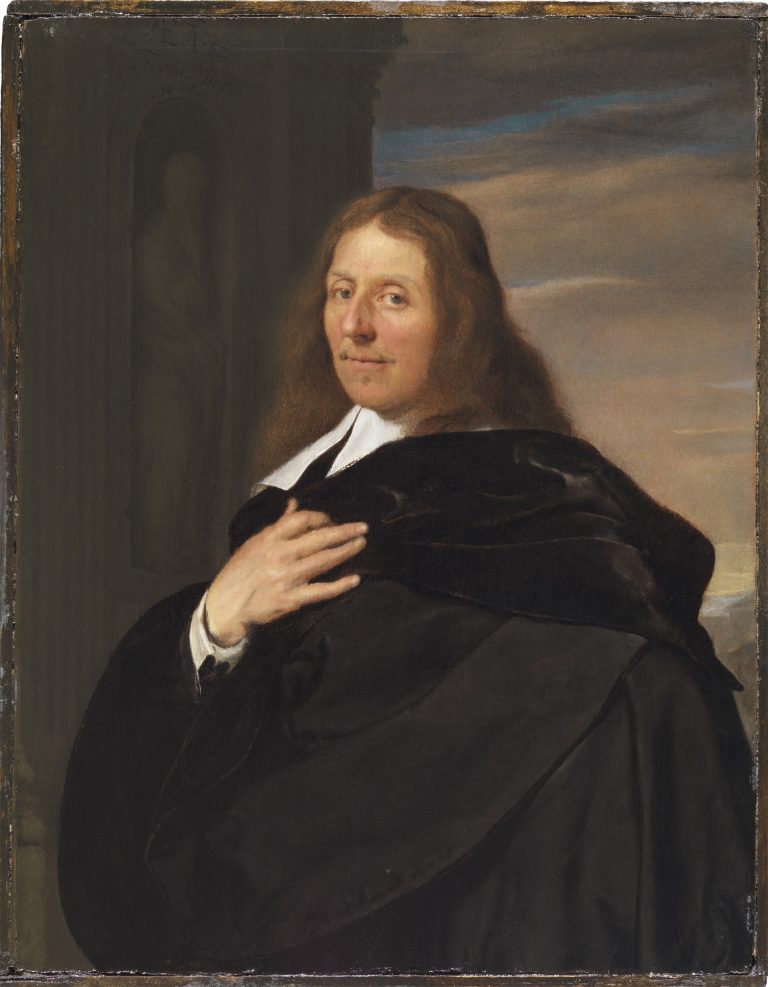The refined paintings that Frans van Mieris produced with saintly patience made him renowned during his lifetime both in his own country and abroad. Like Gerrit Dou (1613–75), he was among the best-paid painters of the Golden Age. From the voluminous book of inventories of the estates of people living on Rapenburg in Leiden, it can be inferred that Van Mieris’s paintings were always more highly valued than those by his contemporaries.1 These inventories also provide a unique picture of the varied social status, financial position and religious background of some of his buyers, as well as the composition and size of their collections. Van Mieris built a devoted clientele in Leiden that included Franciscus de le Boë Sylvius (1614–72), an internationally famous professor of chemistry and medicine whom Houbraken described as Van Mieris’s patron.2 The 1673 inventory of Sylvius’s estate—his house at Rapenburg 31 still stands today—indicates that he possessed seven works by Van Mieris and an astonishing eleven by Dou.3 Houbraken states explicitly that Sylvius gave Van Mieris regular commissions and had the first right of purchase of his works for a fixed fee.4
Among the works by Van Mieris described in the inventory of Sylvius’s estate was a painting of “the deceased with his second wife by Van Mieris.”5 Without doubt, the overly labored double portrait of a couple of 1672 in Dresden is the painting described in the inventory, which was drawn up only a year after the completion of the painting (fig 1).6 This hypothesis was first proposed by Otto Naumann, who noticed that the face of the man, with his wide, flat and square chin, is identical to that in the engraving of Sylvius that Cornelis van Dalen (1638–64) made in 1659 (fig 2).7 The convincing likeness is confirmed by a description of the painting in the 1678 inventory of Sylvius’s nephew Jean Rouyer: “The portrait of Professor Sylvius and his wife playing the lute.”8 The genre-like portrait is in effect an “in memoriam” painting for Sylvius’s second wife, Margareta Lucretia Schlezer, who died before it was finished. The lute is a well-known reference to the harmony of love.9 The professor is known to have owned at least six portraits of himself, painted, drawn, and engraved, including the 1659 print.10
Naumann has tentatively proposed that the present painting, fully signed and dated 1665, also represents Sylvius; however, this identification cannot be supported.11 The inscription in the upper left corner of the present painting, “Aetatis 52,” which is repeated on the back of the panel, clearly gives the age of the sitter as fifty-two, but Sylvius would not reach that age until 15 March 1666.12 Moreover, the sitter does not resemble the man portrayed in Van Dalen’s 1659 engraving.13 Although the moustache and goatee are comparable, his face is narrower and his hair is less curly. Finally, the inventory of Sylvius’s estate lists all the paintings in his collection, including the family portraits, but this work is not among them.14
The sitter’s rich black cloak, which typifies the man as a well-to-do burgher from Leiden, is brilliantly rendered, much to the liking of contemporary viewers (for more on this subject, see FM-110.a and FM-110.b). In its depiction of such vestments, the portrait is akin to Portrait of a Man of 1663 (Galleria degli Uffizi, Florence) and Portrait of Florentius Schuyl of 1666 (Royal Picture Gallery Mauritshuis, The Hague).15 The simplicity and balance of the present painting is striking, as Van Mieris’s portraits of male sitters are usually somewhat labored. The backdrop of architecture with a classical ambience and a cloudy sky that Van Mieris introduced in this work adds to the sitter’s grandeur. In a similar manner, Van Mieris modeled the man’s elegant gesture on the portrait idiom of the Flemish painter Anthony van Dyck (1559–1641), whose famous series of portraits, the Iconographie, had been engraved in 1645.16
